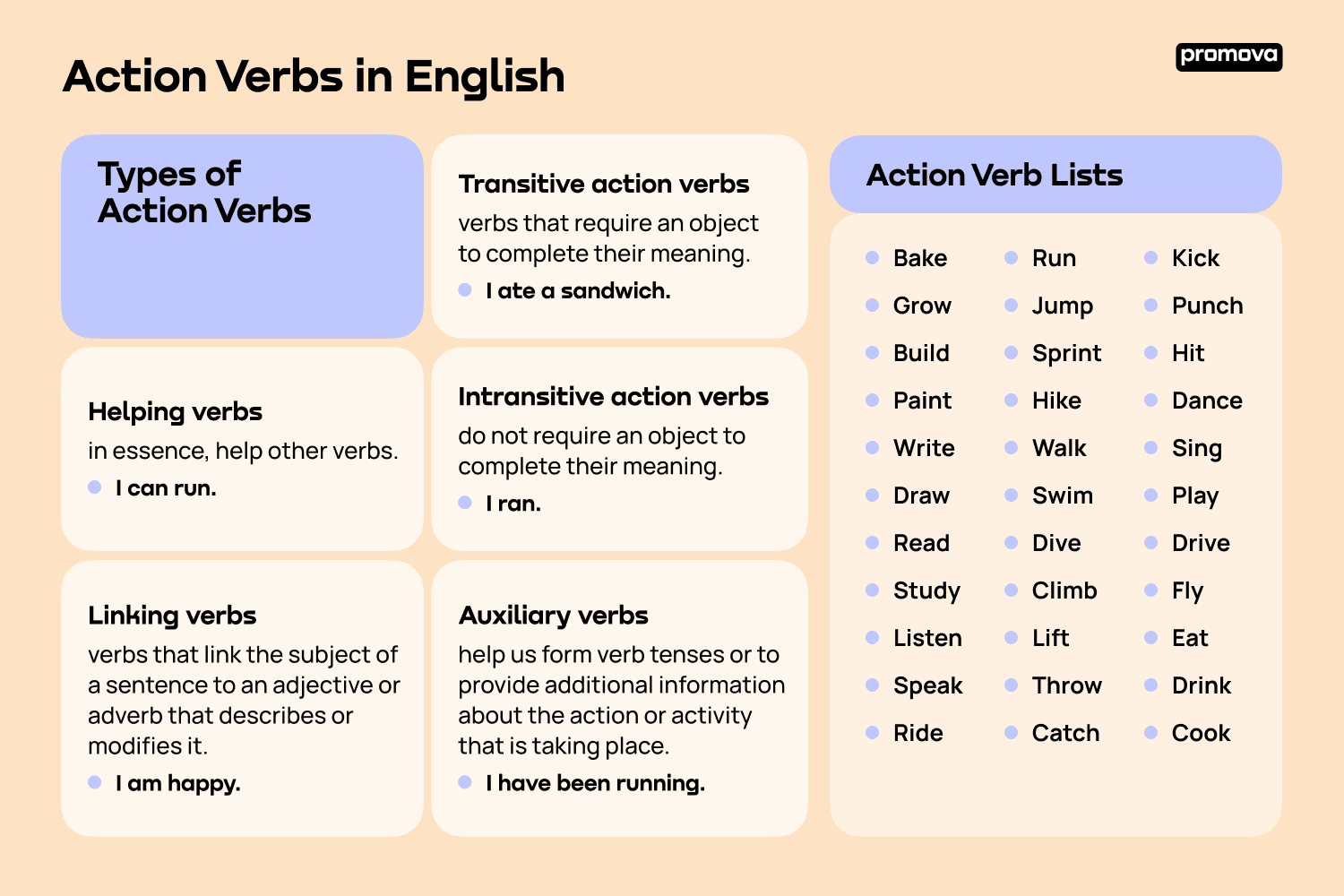Action Verbs in English
Contents
In this reference, we'll explore the definition of action verbs, their importance, types, lists, examples, forms, and tips for choosing the right action verbs.
Let's start learning!
What Are Action Verbs?
Action verbs are words that describe the action that is taking place in a sentence. They are used to indicate what someone or something is doing. Action verbs can be either physical or mental. Physical action verbs describe physical activities, like running, swimming, or jumping. Mental action verbs, on the other hand, describe mental activities, such as thinking, believing, or knowing.
Action verbs, also known as dynamic verbs, or dynamic action verbs are very common. They help us express action or activity in a sentence. They can be used to describe specific actions, events, or states of being.
The Importance of Action Verbs
Action verbs are essential in the English language and communication. They are used to express action and activity in a sentence. They are used to show what is happening in a sentence and to make the sentence more interesting and dynamic.
Action verbs are also important because they help to make the sentence more specific. For example, instead of saying, "I walk," you can say, "I stroll" or "I saunter." This makes the sentence more descriptive and vivid.
The right action verbs are also useful for adding emphasis to a sentence. For example, instead of saying, "I am reading," you can say, "I am devouring the book." This makes the sentence more expressive and conveys a stronger sense of the action that is taking place.
Types of Action Verbs
Action verbs can be divided into two main types: transitive and intransitive.
- Transitive action verbs are verbs that require an object to complete their meaning. For example, "I ate a sandwich" is a sentence with a transitive action verb because the verb "ate" requires an object (the sandwich) to complete its meaning.
- Intransitive action verbs do not require an object to complete their meaning. For example, "I ran" is a sentence with an intransitive action verb because the verb "ran" does not require an object to complete its meaning.
Action verbs can also be divided into other types, such as linking verbs, auxiliary verbs, and helping verbs.
- Linking verbs are verbs that link the subject of a sentence to an adjective or adverb that describes or modifies it. For example, "I am happy" is a sentence with a linking verb because the verb "am" links the subject "I" to the adjective "happy."
- Auxiliary verbs help us form verb tenses or to provide additional information about the action or activity that is taking place. For example, "I have been running" is a sentence with an auxiliary verb because the verb "have" is used to form the verb tense "been running."
- Helping verbs, in essence, help other verbs. For example, "I can run" is a sentence with a helping verb because the verb "can" is used to help the verb "run."
Action Verb Lists
Here is a handy list of action verbs for you to use:
- Run
- Jump
- Sprint
- Hike
- Walk
- Swim
- Dive
- Climb
- Lift
- Throw
- Catch
- Kick
- Punch
- Hit
- Dance
- Sing
- Play
- Drive
- Fly
- Eat
- Drink
- Cook
- Bake
- Grow
- Build
- Paint
- Write
- Draw
- Read
- Study
- Listen
- Speak
- Ride

Examples of Action Verbs in Sentences
Here are some examples of action verbs in sentences:
- "I ran to the store."
- "She wrote a letter."
- "They climbed the mountain."
- "We ate dinner."
- "You sang a song."
- "He jumped over the fence."
- "She swam in the pool."
- "They danced in the rain."
1
Action Verb Forms
Action verbs can be used in different forms. They can be used in the present tense, past tense, and future tense.
In the present tense, action verbs are used to express ongoing or habitual actions. For example, "I am eating" or "He is swimming."
In the past tense, action verbs are used to express actions that have already happened. For example, "I ate" or "He swam."
In the future tense, action verbs are used to express actions that will happen in the future. For example, "I will eat" or "He will swim."
How to Use Action Verbs
Action verbs are used to express action and activity in a sentence. They are used to show what is happening in a sentence and to make the sentence more interesting and dynamic.
When using action verbs, it's important to make sure that the verb agrees with the subject of the sentence. For example, if the subject of the sentence is "I," then the verb should be in the first person singular form (e.g., "I eat"). If the subject of the sentence is "we," then the verb should be in the first person plural form (e.g., "we eat").
It's also important to make sure that the verb tense is correct. For example, if the action is happening now, then the verb should be in the present tense (e.g., "I am eating"). If the action has already happened, then the verb should be in the past tense (e.g., "I ate").
Summary
Action verbs help us express physical or mental action and activity. They can be used to describe specific actions, events, or states of being. It's important to understand what action verbs are and how to use them to express yourself in English effectively.
We hope that this reference has helped you to better understand the concept and apply it in your daily life!
Comments